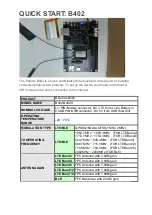
binary one. The least significant bit is output first. As few bits as possible are displayed, all leading
zeros are ignored. The application program defines the values of the alarm codes.
The table below shows the meaning of the sequences.
Sequence
CONTROLLER STATUS CODE
Off
0 = Normal
1 Long
I/O Module Error Indication
1 Short, 1 Long
Register Assignment Checksum Error
2 Long
I/O Module Error and Register Assignment Checksum Error
2 Short, 1 Long
Too many I/O operations requested
3 Long
5 = I/O Module Error Indication and Too many I/O operations
requested
3 Short, 1 Long
6 = Register Assignment Checksum Error and Too many I/O
operations requested
4 Long
7 = I/O Module Error and Register Assignment Checksum
Error and Too many I/O operations requested
6.6.1
I/O Module Error Indication
When the Status LED flashes the controller status code 1 (i.e. a long flash, once every second), there
is a communication failure with one or more I/O module. To correct the problem, do one of the
following:
•
Ensure that every module contained in the Register Assignment Table is connected to the
controller. Check that the module address selected for each module agrees with the selection
made in the Register Assignment Table.
•
If a module is still suspect of having failed, confirm the failure by removing the module from the
Register Assignment Table. Download the changes to the controller. The Status LED should stop
flashing.
•
If a module is currently not connected to the controller, delete it from the Register Assignment
Table. Download the changes to the controller. The Status LED should stop flashing.
•
If unused modules must be intentionally left in the Register Assignment Table, the I/O error
indication may be disabled from a selection box on the Register Assignment dialog.
6.6.2
Register Assignment Checksum Error
When the status LED flashes the controller status code 2 (i.e. a short flash then a long flash followed
by a 1 second of delay), this indicates the register assignment is not valid. To correct this problem,
initialize the register assignment using the TelePACE or ISaGRAF software, or alternatively,
perform a COLD BOOT as described in section
of this manual. The status LED
should stop flashing.
6.6.3
Too Many I/O Operations Requested Error
When the status LED flashes the controller status code 4, this indicates that more I/O operations
were requested than the I/O system could handle. This error should only occur with custom C++
applications. It indicates the custom application is requesting I/O operations faster than the system
can process them and that the queue of pending operations is full. The custom application should
reduce the rate at which it makes requests.
SCADAPack 32P Controller Hardware Manual
May 26, 2006
32









































